YOU NEED A PITCHFORK IN YOUR QUIVER
The Choice is Yours
Plants occasionally need fertilizer and when they do, you can choose between using either an organic fertilizer or a synthetic (aka chemical) fertilizer. Organic fertilizers are derived from natural sources such as ground rocks, animal byproducts and manures, and plants or parts of plants. Synthetic fertilizers, in contrast, are factory made.
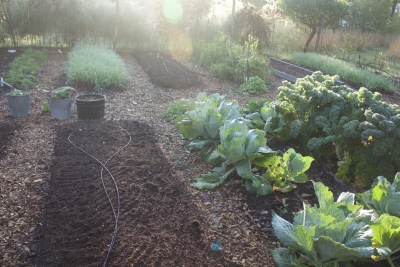
“Fertilized” beds in autumn
Most of the nutrition plants get from the ground is from nutrient ions (an atom or a group of atoms with an electric charge). For instance, calcium enters the root as Ca++; the two pluses are the result of the once neutral calcium atom losing two electrons. Whether a fertilizer is organic or synthetic, the form the plant eventually sees as food is an ion. People sometimes use this as a argument that it doesn’t matter to the plant whether its food source is organic or synthetic. But . . .
Different Effects
Because organic fertilizers are derived from natural sources, nutrients in them typically are locked up in a witches’ brew of organic molecules, unavailable to plants. This is an advantage often overlooked when considering organic versus synthetic fertilizers.
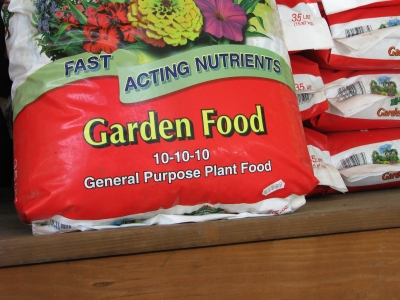
“Synthetic” fertilizer
Nutrients locked up in organic fertilizers spring into action when warmth and moisture stimulate microbial activity. Warmth and moisture are the same conditions that make plants grow. Bingo! Plants are then offered food according to their needs and excess fertilizer doesn’t sit around in the soil where it can be leached away by rainfall.
What’s more, a single application of organic fertilizer, doling out a steady diet in synch with plant needs, can provide sufficient nourishment to last the whole growing season.
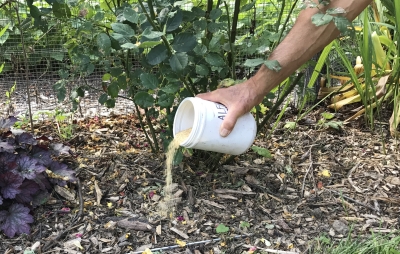
Applying soybean meal fertilizer, once per season
By contrast, a single application of a synthetic fertilizer in a large enough dose to last the whole season would likely burn plant roots. (Being “salts,” in the general sense of an ionic compound, they can draw water out of cells in the same way salty potato chips can dry out your lips.)
Because they are generally soluble, synthetic fertilizers also are more likely to wash away through the ground before plants get to use them.
I have in front of me a recommendation for fertilizing blueberries. Various synthetic fertilizers are suggested. To avoid burning roots, the recommendation is to split the total amount of fertilizer required into four or even six applications. My blueberries look very healthy and yield very well, thank you, and when I have fertilized them, using an organic fertilizer, it was once per season.

My “fertilized” blueberries
Other differences between organic and synthetic fertilizers might also warrant using one over the other. Organic fertilizers are rife with impurities. Synthetic fertilizers are relatively pure materials; “Oh goody,” you might say. Wait: these “impurities” are another plus for organics because they include some nutrients needed by plants in only small quantities, so-called trace elements.
You might choose to use organic fertilizers for reasons that are philosophical rather than for their effects on soil and plants. All sorts of “garbage,” from feedlot manure to sewage sludge to brewery wastes to kitchen waste can be recycled into compost, a nutritious, organic plant food. Organic materials make up a significant portion of landfills, in which these materials putrify to release methane, the largest human-made contributor to atmospheric methane and itself a far more potent greenhouse gas than carbon dioxide.
But Best of All Is . . .
Many commercially available organic fertilizers are made from blends of one or more organic materials rich in the “big three,” nitrogen, phosphorus, and potassium, the three nutrients needed in greatest amounts by plants. Particular blends vary in their concentrations of nutrients and in how quickly the nutrients become available to plants.
However, much of the benefit in feeding plants organically comes not from the nutrients these fertilizers contain, but from the bulk associated with those nutrients. Among other benefits, this bulk helps soils hold water and air, renders nutrients already in the soil more available, and helps prevent diseases.
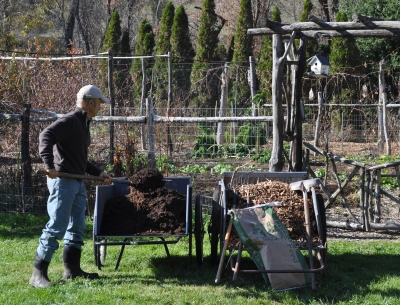
Bulky organic “fertilizers”
Keep in mind that the more concentrated a fertilizer, the less bulk it has. A concentrated organic fertilizer like blood meal is as lacking in bulk as any synthetic fertilizer. Also, an organic fertilizer such as Chilean nitrate is legally considered “organic” only because it is mined and not manufactured; it’s identical the chemical fertilizer sodium nitrate. Don’t consider concentrated fertilizers of any sort as alternatives to keeping a soil well fed with compost, leaves, straw, and other bulky materials.
Earlier on, mentioning the health of my blueberry plants, I chose my verb tense carefully in writing “when I have fertilized them.” I no longer fertilize them per se. For decades I annually spread about a 3 inch depth of leaves, arborist wood chips, sawdust, or some other weed free organic mulch beneath the plants after spreading soybean meal for extra nitrogen. Since realizing that growth was too vigorous, with two to three feet of new growth each year, I decided to forgo the soybean meal. Even low nutrient stuff like those mulches eventually should release some nitrogen and other necessary elements into the ground as they decompose. (Legally, they’re nutrient content, that of compost also, is too dilute to allow them to be classified as “fertilizer.”) For the past few years now, only mulch and the rich reserve of organic matter in the soil from years of mulching keep my blueberries healthy and productive.

My “fertilized”/mulched blueberries (not Sammy)
Vegetable plants are hungrier than blueberry plants, so the annual feeding regime in my vegetable garden was soybean meal and, for its relatively rich nutrient content among bulky, organic materials, compost. (Past tense again.) It’s been a few years since I similarly did away with the soybean meal and relied for fertility only on compost, with which I annually lather the beds.

Bed preparation, including “fertilization” with compost
There’s no substitute for a pitchfork in good gardening.
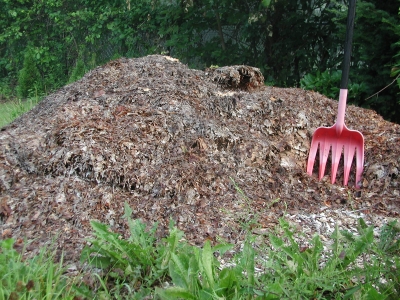
Leaves for mulch mulch


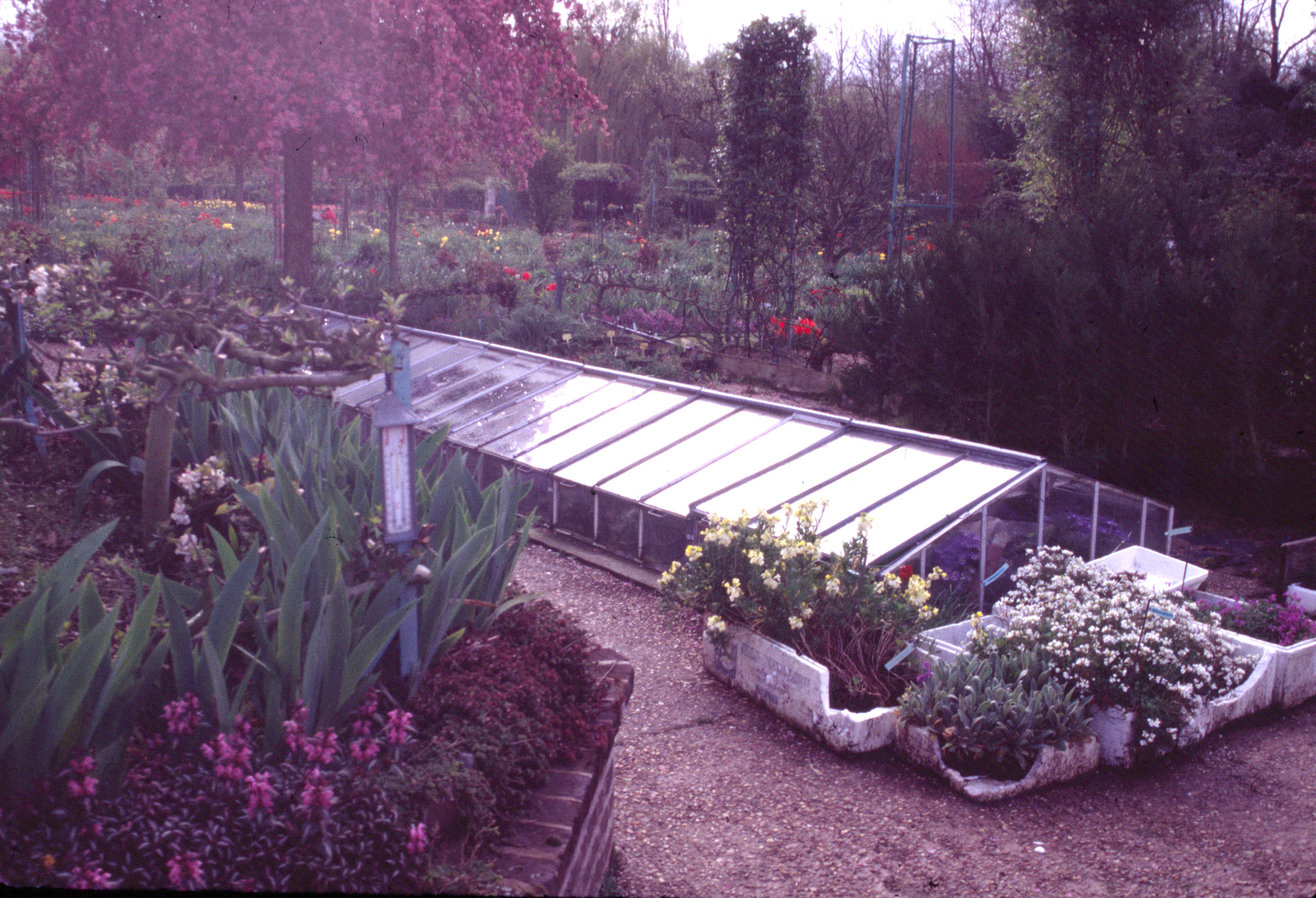
Great timing, Lee! Thank you as ever for sharing your gardening life with us. I truly appreciate your words, wisdom and advice.
Thank you for your comment.
Didn’t see anything on pH for your blueberries. Are you still having to add anything to lower it or does it stay low enough? If so what do you add?
Organic matter, with which my blueberry soil is well endowed after decades of mulching, buffers pH to allow more wiggle room. Every few years I check it, and if it’s too high, I add the amount of sulfur needed to lower it. I also keep an eye on the foliage for signs of iron deficiency, which would be the result of a pH insufficiently low.
Hey lee I’ve heard that an inch of compost is really all you need to keep your soil fertile annually. I have heard of some issues with this. One I believe potassium is the slowest to leach out of soils. In Particular heavy clay but can build up over repeated applications through the years to over saturated amounts? Wile the other macro nutrients can be represented on the low to deficit end. Is this true? I have also heard that if you intensely plant, along with some heavy feeding crops such as corn the compost doesn’t nessacarly provide enough Nitrogen. Is that true in your experience with your own garden?
Yes, my potassium and phosphorus levels are excessive. But I have not seen any negative effects on the plants. One possible explanation is that soil tests are geared to mineral soils. My soil, after many years of surface applications of compost is more, as one soil scientist described it, a “growing medium.” Those K and P levels might not translate to such a soil.
As i wrote the macronutrient most likely to be limiting is N. That’s why I used to also make annual additions of soybean meal. After I repeatedly made calculations of the release rate of N from compost, I decided to forgo the soybean meal. And everything grows just fine. And I do grow corn, intensively.
I am planning some testing to solidify my results. Tissue testing. Adding soybean meal in parts of some beds to see if there’s any improved growth.